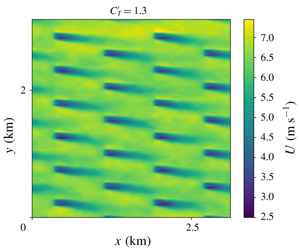Crossref Citations
This article has been cited by the following publications. This list is generated based on data provided by
Crossref.
Lun, Ma.
Dunstan, Thomas D.
and
Nishino, Takafumi
2020.
Analysing momentum balance over a large wind farm using a numerical weather prediction model.
Journal of Physics: Conference Series,
Vol. 1618,
Issue. 6,
p.
062010.
Ghaisas, Niranjan S.
2020.
A Predictive Analytical Model for Surface Shear Stresses and Velocity Profiles Behind a Surface Roughness Jump.
Boundary-Layer Meteorology,
Vol. 176,
Issue. 3,
p.
349.
Antonini, Enrico G. A.
and
Caldeira, Ken
2021.
Spatial constraints in large-scale expansion of wind power plants.
Proceedings of the National Academy of Sciences,
Vol. 118,
Issue. 27,
Ouro, Pablo
and
Nishino, Takafumi
2021.
Performance and wake characteristics of tidal turbines in an infinitely large array.
Journal of Fluid Mechanics,
Vol. 925,
Issue. ,
Patel, Kelan
Dunstan, Thomas D.
and
Nishino, Takafumi
2021.
Time-Dependent Upper Limits to the Performance of Large Wind Farms Due to Mesoscale Atmospheric Response.
Energies,
Vol. 14,
Issue. 19,
p.
6437.
Segalini, A.
2021.
An analytical model of wind-farm blockage.
Journal of Renewable and Sustainable Energy,
Vol. 13,
Issue. 3,
Juniper, Marcus C R
and
Nishino, Takafumi
2022.
A data-informed analytic model for turbine power prediction with anisotropic local blockage effects.
Journal of Physics: Conference Series,
Vol. 2265,
Issue. 2,
p.
022046.
Kirby, Andrew
Nishino, Takafumi
and
Dunstan, Thomas D.
2022.
Two-scale interaction of wake and blockage effects in large wind farms.
Journal of Fluid Mechanics,
Vol. 953,
Issue. ,
Li, Chao
Liu, Luoqin
Lu, Xiyun
and
Stevens, Richard J.A.M.
2022.
Analytical model of fully developed wind farms in conventionally neutral atmospheric boundary layers.
Journal of Fluid Mechanics,
Vol. 948,
Issue. ,
Legris, Leila
Pahus, Morten Lindholt
Nishino, Takafumi
and
Perez-Campos, Edgar
2022.
Prediction and Mitigation of Wind Farm Blockage Losses Considering Mesoscale Atmospheric Response.
Energies,
Vol. 16,
Issue. 1,
p.
386.
Huang, Bin
Gong, Yinchen
Wu, Rui
Wang, Pengzhong
Chen, Jiacheng
and
Wu, Peng
2022.
Study on hydrodynamic performance of a horizontal axis tidal turbine with a lobed ejector.
Ocean Engineering,
Vol. 248,
Issue. ,
p.
110769.
Ma, Lun
Delafin, Pierre-Luc
Tsoutsanis, Panagiotis
Antoniadis, Antonis
and
Nishino, Takafumi
2022.
Blade-Resolved CFD Simulations of a Periodic Array of NREL 5 MW Rotors with and without Towers.
Wind,
Vol. 2,
Issue. 1,
p.
51.
Stevens, Richard J.A.M.
2023.
Understanding wind farm power densities.
Journal of Fluid Mechanics,
Vol. 958,
Issue. ,
Kirby, Andrew
Briol, François‐Xavier
Dunstan, Thomas D.
and
Nishino, Takafumi
2023.
Data‐driven modelling of turbine wake interactions and flow resistance in large wind farms.
Wind Energy,
Vol. 26,
Issue. 9,
p.
968.
Kirby, Andrew
Dunstan, Thomas D.
and
Nishino, Takafumi
2023.
An analytical model of momentum availability for predicting large wind farm power.
Journal of Fluid Mechanics,
Vol. 976,
Issue. ,
Juniper, Marcus C.R.
and
Nishino, Takafumi
2023.
Single and multi-row turbine performance in bounded shear flow.
Journal of Fluid Mechanics,
Vol. 957,
Issue. ,
Stipa, Sebastiano
Ajay, Arjun
Allaerts, Dries
and
Brinkerhoff, Joshua
2024.
The multi-scale coupled model: a new framework capturing wind farm–atmosphere interaction and global blockage effects.
Wind Energy Science,
Vol. 9,
Issue. 5,
p.
1123.
Stipa, Sebastiano
Allaerts, D.
and
Brinkerhoff, J.
2024.
A shear stress parametrization for arbitrary wind farms in conventionally neutral boundary layers.
Journal of Fluid Mechanics,
Vol. 981,
Issue. ,
Pahus, M L
Nishino, T
Kirby, A
and
Vogel, C R
2024.
Control co-design of a large offshore wind farm considering the effect of wind extractability.
Journal of Physics: Conference Series,
Vol. 2767,
Issue. 9,
p.
092026.
Azam, Muhammad
Zafar, Laiba
Bhatti, Haq Nawaz
and
Khan, Amina
2024.
Wind Energy Storage and Conversion.
p.
83.
